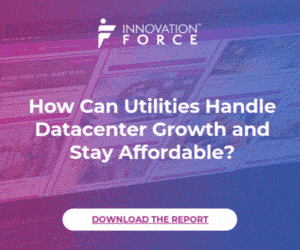We are in an era of load growth – data centers, manufacturing and electrification are driving electricity demand. On the other side of the equation, DERs and storage are also entering the system. All these resources share one need – to be interconnected to the grid. This puts utilities at the front and center of that development. Yet today’s interconnection process wasn’t designed to scale. The result? Exploding queues, extended lead times and growing pressure on utility workforces. In addition, developers’ uncertainty and concern about their applications and project delays put more strain on the overall system. To unlock interconnection queues, we need to automate and provide end- customers with increased information. Utilities are seeing that with the correct tools and insight, they can greatly reduce the pressure on their grid and operations and boost efficiencies.
Seven challenges facing electric utilities:
- Manual processes: Most of the processes to handle and assess interconnections are manual and require skilled engineers to perform. Handling a single interconnection application – from building a grid model to running the required impact analysis – can take days or even weeks.
- Customer demands: Commercial customers require transparency and information to be able to assess the business case for a project to interconnect. While hosting capacity maps are a first step, they do not provide all the information required. The results are time-consuming requests to utility DER teams and speculative applications that lead to an even heavier (and avoidable) workload.
- Resource constraints: Although faced with more workload and requirements, utilities are resource-constrained, particularly as regulators push to keep rates flat. This means that hiring additional staff is often not a viable option and utilities must do more with less.
- Data-management complexities: While utilities generate massive amounts of data, many struggle with siloed systems, inconsistent data quality, difficulty easily accessing the data and the inability to leverage the data. Effective data collection, integration and analysis are essential for informed decision-making and operational efficiency.
- Workforce transition: The industry faces the dual challenge of an aging workforce approaching retirement and a shortage of skilled personnel to replace them. This gap affects maintenance, operations and technology adoption – highlighting the urgent need for knowledge transfer and workforce development initiatives.
- External uncertainties: Utilities must navigate unpredictable variables, including increasing regulatory requirements. Extreme weather events and fluctuating energy demands also cause strain. Building resilience and adaptability into core operations has become critical to managing these uncertainties.
- Rapid interconnection demand: Utilities often struggle to process the growing demand for interconnection requests, largely driven by renewable energy projects (i.e. solar and battery storage) and data centers. Wait times can be over three years.
Why digitalization is no longer optional
Modernizing grid infrastructure has transitioned from a strategic advantage to a fundamental necessity. For decades, utilities have managed vast amounts of data using legacy systems that can trap information in inaccessible silos. As demand and complexity in projects increase, grid operators face overwhelming interconnection requests. The root cause? Outdated data management methods and limited automation capabilities.
To unlock their full operational potential, utilities must integrate fragmented data sources and make data more accessible – internally and externally. Only through this digital transformation can the pathway to automation be realized – driving efficiency and eliminating bottlenecks that impede progress. You can’t automate if you don’t have access to the data. We partner with utilities to co-build the right solution by uncovering current data, workflow and business operations.
How to leverage existing data
To help utilities tackle interconnection and long-term grid investment, we created the envelio Intelligent Grid Platform (IGP). We leverage a utility’s existing data, create a digital twin of its entire grid and enable stakeholders to more easily access data. The result is automation and efficiency across the system.
The envelio IGP streamlines interconnection processes, allows utilities of all sizes to scale the modular platform and enhance grid planning and transparency for real-time insights. Utilities now have a much more efficient and less complicated way to address grid vulnerabilities, visualize and plan hosting capacity, and automate grid connections. Over 70 utilities worldwide, including half the German grid, use the envelio IGP.
Strategic U.S. expansion and key partnerships
Last fall, we secured our first U.S. client – Eversource, an energy provider serving customers in Connecticut, Massachusetts and New Hampshire. Central to our U.S. strategy is growing our partnership ecosystem. Earlier this year, envelio announced a partnership with a key player, Clean Power Research©. This collaboration integrates envelio's Intelligent Grid Platform with Clean Power Research's PowerClerk® – Clean Power Research's leading workflow management solution. PowerClerk® has processed over two million interconnection projects to date. The company’s expertise in streamlining and automating Distributed Energy Resources (DER) interconnection processes has enabled utilities to achieve faster turnaround times, reduce backlogs and enhance stakeholder satisfaction across the board. With this combined solution, utilities are able to scale DERs efficiently while strengthening grid planning and operations.
"By integrating key elements of envelio's Intelligent Grid Platform with PowerClerk®, we're enabling utilities to more extensively automate interconnection workflows, reduce project approval times and enhance grid transparency,” stated Clean Power Research CEO Jeff Ressler. “Our collaboration helps utilities better manage the rapid growth of distributed energy resources like solar, storage and wind."
European success stories: Proven results
Following are examples of three European utilities who have successfully automated:
Helen Electricity Network (Finland) – Tasked with preparing Helsinki's power grid for carbon neutrality by 2030, Helen Electricity Network implemented the envelio Intelligent Grid Platform to optimize planning and future-proof its infrastructure. Advanced grid modeling and scenario-based planning allowed Helen to identify critical bottlenecks and design targeted investment strategies that support Helsinki's ambitious climate goals.
FairNetz GmbH (Germany) – As the distribution system operator for Reutlingen, FairNetz faced mounting challenges with grid connection requests for photovoltaic systems and electric vehicle charging stations. By implementing the envelio IGP, they successfully automated 60% of all connection requests, dramatically improving approval times and enhancing grid visibility.
Syna GmbH (Germany) – Operating one of Germany's largest grid networks, Syna GmbH adopted envelio's IGP to modernize its approach to grid compatibility testing. Previously, manual processes meant evaluations took up to eight hours to complete. With IGP implementation, this evaluation time was reduced to just 15 minutes – dramatically improving both data quality and opera- tional efficiency.
Assessing your automation potential
A utility is well suited to benefit from automation and modernization if it can answer "yes" to most of these questions or statements. (The fact is, regardless of a utility’s digital progress or readiness, it is already positioned to greatly benefit from automation.)
- Data accessibility and quality
- Is your team frustrated with having to access disburse systems for data? Afterwards, will they have to build one-off models with potentially outdated data?
- Are you experiencing increased interconnection requests for DERs such as solar systems and EV charging stations?
- Can you effectively assess the real-time impact of DERs on your grid?
- Are your current processes for managing interconnection requests and grid planning time-intensive and labor-dependent?
- Have you identified operational bottlenecks that could be addressed through automation?
- Do you see increased demand from data centers and other digital infrastructure plans in your region?
- Are you leveraging scenario-based planning tools to forecast future grid demands and potential constraints?
- Are you simulating various grid conditions to guide investment and operational decisions?
- You want to abide by regulatory mandates for grid modernization and carbon reduction but are not sure of the most efficient path.
- You could benefit from an integrated technology roadmap for addressing these challenges.
Integration of distributed energy resources (DERs)
Process efficiency
Growth in data center and AI
Advanced planning and simulation
Regulatory and strategic alignment
Building resilience and future readiness
The push toward renewable energy adoption extends beyond sustainability – it's becoming essential for long-term viability. Utilities need to plan future capacity with precision and leverage predictive analytics to strengthen networks against extreme weather events and rising energy demands. This is exactly what our platform enables.
Through comprehensive digitalization and automation, utilities can keep pace with change…and even lead it. By modernizing their operations, grid operators can prioritize sustainability, accelerate clean energy adoption and build resilient networks prepared for tomorrow's challenges.

Luigi Montana serves as CEO of envelio Inc., leading the organization's North American operations and strategy. Before relocating to the United States to lead U.S. expansion, Montana held various leadership positions at envelio and other European companies, managing large-scale IT projects, complex investment planning, financial decision-making and organizational transformation initiatives. Montana holds a Master's degree from HHL Leipzig Graduate School of Management in Germany and a Bachelor's degree from Bocconi University in Milan, Italy.
Founded in Germany in 2017, envelio GmbH (the parent company) is an award-winning energy software company providing advanced automation, interconnection and grid planning solutions to more than 70 utilities worldwide.







